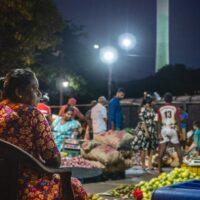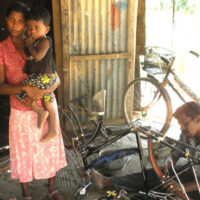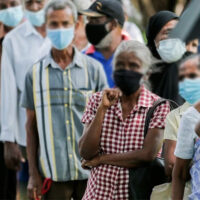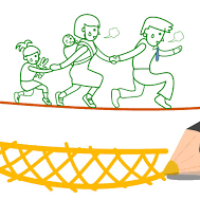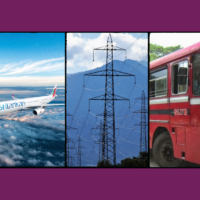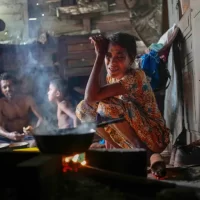Transitional Justice: Looking Back to Move Forward
By Natasha Palansuriya
Transitional Justice – Sinhala
—
Transitional Justice – the term, the process, the concept – has always been a contentious topic in post-war Sri Lanka. The underlying reason for this is how it has been painted by successive governments and politicians to further their own agendas, but also how it has been communicated by media – creating common misconceptions about transitional justice amongst the general public. Some of these misconceptions are: (1) It is an attack against our armed forces; (2) It is devised by the West to undermine Sri Lanka; (3) It threatens the sovereignty of our country; (4) we do not need transitional justice – the war is over we can move on.
Whilst the need for justice is imperative in a fragile post-war context such as the one in Sri Lanka, it has not always received the same urgent and/or positive response from all stakeholders involved. This is especially witnessed from the state and ultra nationalist groups that oppose the idea of transitional justice and the perceived ‘international interference’ that comes with it. Similarly, it is seen as a process that is not ‘owned’ by Sri Lanka, and ‘forced’ on Sri Lanka thereby attacking the sovereignty of the nation. Another line of argument against transitional justice is that it does not help to dig up old wounds, that we must forget the past and move on. This article will unravel these arguments, separate the politics that cling to “transitional justice”, and discuss why we need the process of justice after a violent armed conflict.
Is Transitional Justice and Reconciliation the Same?
We hear this term thrown around in political debate – Transitional Justice – sometimes interchangeably with the term ‘reconciliation’. What does it really mean and are they the same thing? In the simplest sense transitional justice is the range of processes and mechanisms that is aimed to help a society to come to terms with the violent and painful legacy that was left behind after a civil war. A society can come to terms with this and move on when accountability for crimes is ensured and when justice is served. And then, and only then, can reconciliation be achieved. This partly answers the question if transitional justice and reconciliation are the same thing – most definitely not. An important element of transitional justice is reconciliation, which most nations coming out of conflict aim to achieve. Reconciliation takes place when the parties who were in conflict with each other come together with mutual respect, agree to a common understanding of the injustices caused during the war from all parties, and restore peaceful and amicable relationships between all communities affected by the conflict. Therefore, in essence transitional justice is the vehicle that takes you to ‘reconciliation’ – the destination.
This article will only focus on the vehicle – transitional justice – and deconstruct the misconceptions that are common in Sri Lanka and have been reinforced by successive political forces and media.
It is an attack against our armed forces
The aim of transitional justice is to bring justice to victims who suffered grave violations during a conflict. Some of the injustices caused during conflict are discrimination, hate crime, targeted rape, ethnic cleansing, involuntary displacement, forced conscription, hunger and disease, loss of home and livelihood, lack of access to economic opportunity and to legal redress. When such crimes are committed justice must follow because we are a civilised law-abiding nation, bound by a constitution that recognises a set of fundamental principles based on justice, the rule of law, and human rights. The armed forces too are governed by the same rules. Moreover, it is clearly understood that these violations are not committed just by armed forces, it is also committed by rebel groups. Even in the statement made by the UN High Commissioner for Human Rights in February 2021, she stresses the importance
“of a comprehensive accountability process for all violations and abuses of human rights committed in Sri Lanka by all parties, including those abuses by the Liberation Tigers of Tamil Eelam”
This clearly shows that transitional justice is not an attack against armed forces but a mechanism that considers all perpetrators of crimes committed during the war. Similarly, although some in the armed forces committed these crimes, it is only a minority of the armed forces, and does not mean that everyone is considered a perpetrator. It does not by any means dismiss the service of the armed forces to end the war. It does not undermine the efforts by armed forced to protect innocent civilians and help rehabilitate ex-LTTE cadres and resettle those who were displaced. In fact, it recognises that the armed forces sacrificed their lives to save innocent civilians – and that will not be forgotten.
However, it cannot be dismissed that violations have been committed by all parties, which needs to be redressed. This is part of addressing the past, and the importance of addressing the past is that we ensure that these violations do not ever occur again. Moreover, apart from bringing justice to victims of war time violations, by holding perpetrators accountable it will protect the image and dignity of the armed forces and the country at large. If the government wants to be respected as one that upholds the rule of law, then a precedence must be set. In a country where impunity is prevalent, full, and fair justice is the only way to ensure non-recurrence.
It is devised by the West to undermine Sri Lanka
The transitional justice process in Sri Lanka is guided by the UN resolution 30/1 which was co-sponsored by the government and unanimously adopted by the Human Rights Council Members. The Government and the civil society supported by the UN envisaged a complete transitional justice strategy to address the legacy of past violations. For this purpose, the Peacebuilding Priority Plan was drawn up based on the four pillars of Transitional Justice; Reconciliation; Good Governance; and Resettlement and Durable Solutions. ‘Co-sponsored’ essentially means that Sri Lanka drafted this resolution, putting forward steps to promote reconciliation, accountability, and human rights in Sri Lanka. Therefore, it was by no means devised by the West, rather Sri Lanka played a crucial role in drafting the resolution along with US, UK, Montenegro, and Macedonia. This is significant because it means that Sri Lanka is in control of the process and was able to lay out conditions that are suitable for the country. It also showed the international community that Sri Lanka is serious about promoting reconciliation, but more importantly it signalled to the Tamil community that the government does consider their grievances, and there was a sense of hope that justice will ultimately be served and giving back some of the dignity that was lost during the war.
Although this was a strong move by the government, the strides were small and the progress was slow in practically implementing the resolution, albeit certain actions were taken such as release of land, release of some political prisoners held under the Prevention of Terrorism Act (PTA), and the operationalisation of the Office on Missing Persons (OMP) and passing the Act for the Office for Reparations. Sri Lanka as a member state of the United Nations Human Rights Council (UNHRC) has an obligation to act on the resolution passed. Despite only partially doing this, UNHRC granted more time to Sri Lanka by adopting two more roll over resolutions: Resolution 34/1 in 2017 and Resolution 40/1 in 2019, which shows the support given by the international community including ‘the West’. Moreover, the technical support and funding given by the UN to ensure transitional justice and reconciliation in Sri Lanka further speaks to the support given, thus disproving the misconception that transitional justice is devised as a way for the West to undermine Sri Lanka.
It threatens the sovereignty of our country
Sovereignty in essence is the authority of a state to govern itself. Being a sovereign state means that states can make and enforce its own laws, it can define territorial borders, and shape and direct economic performance. But by no means does this mean that states are protected from facing the consequences of oppressing the rights of their own citizens. Although it seems straightforward in theory it is not so black and white in practice. With the emergence of a global market economy states rely more and more on other states thus blurring the lines and questioning the notion of “true” sovereignty – with or without perceived interference from external actors – such as, in this case, supranational bodies like the UN. This is where this perception of “a threat to our sovereignty” comes in when transitional justice is brought up. It seems as if it’s a threat to sovereignty of a nation because the directive is coming from outside vis a vis the UN resolution. Therefore, it appears as though Sri Lanka does not have the power to make its own decisions when it comes to this issue. This rhetoric has been neatly spun by politicians to convince the public that this is not the right course of action for Sri Lanka. For example, when Sri Lanka notified the UNHRC of its intention to withdraw from the resolution, the former Foreign Minister, Dinesh Gunawardena stated that the co-sponsoring of the resolution “remains to date a blot on the sovereignty and dignity of Sri Lanka”. However, as explained in the previous point Sri Lanka ‘co-sponsored’ the resolution that guides the transitional justice mechanism, meaning Sri Lanka was part of the design process, thus refuting the point about Sri Lanka not having power over the decisions made in this regard.
This argument also comes up predominantly because one facet of the transitional justice mechanism is the aspect that interlinks with the law and legal system of the country. This is linked to the ‘Special Courts’ or the special judicial mechanism which was proposed by the Government of Sri Lanka. It was proposed to set up this mechanism with “special counsel to investigate allegations of violations and abuses of human rights and violations of international humanitarian law” (UN Resolution 30/1, article 6). The significance of this is that Sri Lanka recognised the need for a credible and independent justice process, separate from the usual judicial mechanism of the country. This is generally practiced when it comes to transitional justice because the usual judiciary of the country will be overburdened than it already is if it is to also prosecute cases relating to wartime violations. Similarly, this is the first time Sri Lanka has to grapple with such large-scale abuses, thus it does not have the legal framework to prosecute this type of crimes. Therefore, special technical assistance is required to prepare the laws that allow prosecution of war crimes.
Moreover, the mention of foreign judges is another major point of contention that led to this argument regarding the threat to sovereignty. However, what is not mentioned and not popularised to the public is that Sri Lanka will still be in control of the entire process despite having technical know-how and skills from outsiders and will set the conditions on how such a court is to operate. Whether foreign judges will or will not work in the context of Sri Lanka can be challenged. Either way, the more we reject the process and fail to take ownership of it the more we lose our control. Therefore, it is important that we break away from this myth – as it only serves to impede hope of sustainable peace – and take ownership of the process at every level. In an increasingly interlinked system of global governance, it is vital that Sri Lanka takes a seat at the table in the conversation about Sri Lanka.
We don’t need transitional justice – the war is over we can move on
This is a dominant argument specially coming from the Sinhala ultra-nationalist camps. Why do we need to dwell on the past, we defeated terrorism, we won the war, now everything is secure and peaceful, let us not dig up old wounds, let us just move on? Unfortunately, it does not happen this way. Conflicts take place in cycles, if we do not address the root causes then there is most definitely a chance of the conflict recurring. It will manifest itself, sometimes not in the same way, but in different forms and in different times, maybe 10, 20, 30 years from now. We have seen this happening in our history, The 1971 Revolt – the armed insurrection led by the Janatha Vimukthi Peramuna (JVP), which remerged again in 1987 and lasted until 1989. In the 1980s the LTTE insurgency also increased culminating in the civil war from 1983 onwards. Whilst the war ended in 2009 with the defeat of the LTTE, more than a decade later we still see structural violence playing out in other forms, with the proliferation of inter-communal and inter-religious conflicts. So, we must ask ourselves even though the war is won is the conflict really over? This reiterates the significance of closure, and the importance of addressing grievances that point to the root causes of the conflict. These causes will prop up over and over again unless justice is served – which signifies why transitional justice is needed even if the war ended 12 years ago. It is important to take stock of where we have been as a country to make sure the way forward does not entail repeating past mistakes.
The transitional justice mechanism proposed through the UN resolution 30/1 has crucial mechanisms that are able to address different aspects, and when brought together can bring a holistic solution to injustices of the war. For example, the Truth Commission can reveal the truth of what happened during the war. The truth can be different to different people depending on one’s perspective of the war, but through acknowledging the different truths i.e., the different narratives of the war, healing and closure can be attained. What is important to note is that the Truth Commission can only record witness statements but not prosecute perpetrators. It is significant because not only victims but also perpetrators have the ability to speak their version of the war and have it acknowledged publicly. In countries such as South Africa the truth commission has led to deep healing and restoration of relationships between enemies – leading one step closer to reconciliation. The records of the Truth Commission can also lead to identifying the whereabout of those who went missing or disappeared during the war. This leads to the function of the Office on Missing Persons (OMP) who is equipped to find out what happened to those who are missing or disappeared and based on the findings provide redress to the families. The OMP started their work in 2017 and have been able to provide ‘Certificates of Absence’ which acts as legal documentation that families can use in claiming land or other assets or finances that would have been registered in the name of the missing or disappeared. There is a lot more the OMP must do, as mothers are still protesting and spending their days in agony over not knowing the whereabouts of their children. The Office of Reparations is another mechanism that can give financial relief to those who were victimised and suffered during the war – it may not be enough on its own to give compensation and move on – but combined with the other mechanisms can bring great relief to families – specially those who lost entire livelihoods as an effect of the war. Finally, the Special Court, which is the other mechanism, which was explained in the section above, can bring punitive justice by prosecuting those who committed the most heinous of crimes during the war. This also plays a role in sending a message regarding the consequences of committing such crimes and could deter and prevent it from happening in the future.
More importantly, people yearn to have their suffering acknowledged. This is what the transitional justice process, if applied holistically, can give victims from all sides of the conflict. This has been illustrated in the CTF report where one mother from of a disappeared in Manthai East has said: “People did not just die, someone killed them. Like the missing, they just did not go missing. Somebody did it”, suggesting that without the truth and justice for what happened people will continue to suffer and delve on the past.
Stuck in the mud with no way forward
This piece was written with the aim of debunking some of the main misconceptions regarding transitional justice as a concept, but also transitional justice in relation to Sri Lanka, with the hope of changing mindsets that can take us closer to accepting the need for such a mechanism for the country to actually be able to move forward and reach a point of reconciliation. Without justice there can be no peace, and until we as a nation take this seriously, we will continue to see conflicts play out in various forms. This can not only implicate the safety and harmony of the country, but also severely impact the economic conditions of the country.
This article explored transitional justice based on the UN resolution as this was the foundation of the mechanism proposed for Sri Lanka. However, this does not mean that it does not have its flaws. Eventually, any mechanism needs to seriously consider what the people want from it. The CTF’s findings are a starting point as it carefully lays out what the people think about and want from the transitional justice process. Whatever government is in power needs to listen to these voices and follow through. Ultimately, justice needs to be served with or without the UN resolution. We will be “stuck” as a country if justice is not served and grievances of victims are not duly addressed – and the past WILL keep haunting us.
Natasha Palansuriya is a Senior Researcher at the Centre for Poverty Analysis, Sri Lanka and is currently reading for her PhD in International Politics at City, University of London.
Photo by Sora Shimazaki from Pexels
